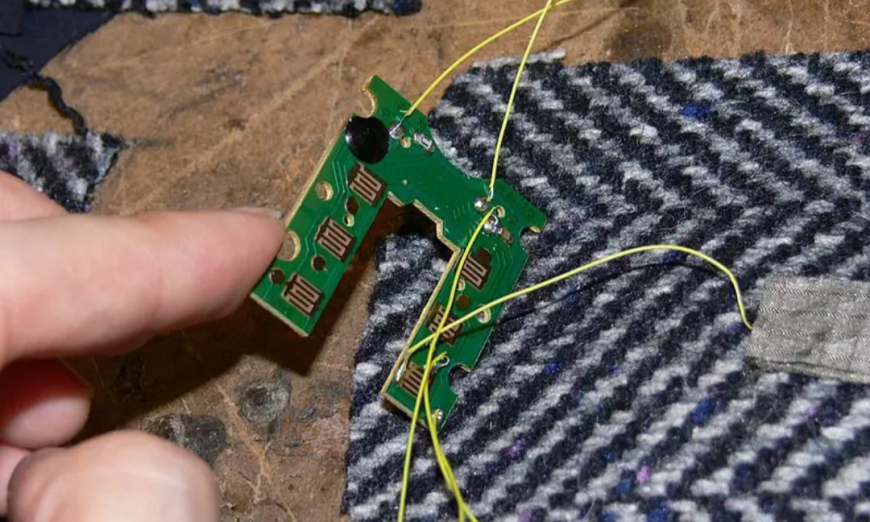A representational image of smart fabric. Photo, Wikimedia Commons.
Sept. 05, 2023. SMART ePANTS, which sounds like ‘smarty pants’ when spoken out loud, is a US government program seeking to develop active smart textiles (AST) with sensors, cameras, and wires woven directly into garments. The person wearing this technology, in the form of a shirt, pants, or underwear, can record audio video in their surroundings, and their location will be trackable via a geolocation sensor.
These ready-to-wear clothes will be stretchable, bendable, washable, and comfortable. They are being developed under the Intelligence Advanced Research Projects Activity (IARPA) — the advanced research and development arm of the Office of the Director of National Intelligence (ODNI). ODNI oversees the US Intelligence Community (IC).
The application of SMART ePANTS will be across agents and employees of intelligence, counterterrorism, and national security agencies like the Central Intelligence Agency National Security Agency, among others.
“This eTextile technology could also assist personnel and first responders in dangerous, high-stress environments, such as crime scenes and arms control inspections, without impeding their ability to swiftly and safely operate,” said a press release by IARPA, which also noted that IARPA invests in high-risk, high-payoff research programs to tackle some of the most difficult challenges of the agencies and disciplines in the IC.
“A lot of the IARPA and DARPA programs are like throwing spaghetti against the refrigerator,” said Annie Jacobsen, author of The Pentagon’s Brain, a book about DARPA. In an interview with The Intercept, she said the program “…may or may not stick.”
IARPA was modeled after DARPA, which focuses on the country’s military needs.
Dr. Dawson Cagle, in charge of the SMART ePANTS program, said, “Although I am very proud of the intelligence aspect of the program, I am excited about the possibilities that the program’s research will have for the greater world.”
“A computer, sensors of some sort, the battery, and the wires and switches that are necessary to connect them have all been developed in one way or another. The SMART ePANTS’ goal is to take all of those individual components and to convert them, to integrate them, into a single device that you can wear.”
Now, it may seem like smart textiles can be connected to your home Wi-Fi. That may be true, but there are two kinds of smart textiles: active and passive. Active smart textiles (AST) are clothes that adapt and change their functionality in response to changes in the external environment or response to user input, be it motion or weather, which means that they would probably have sensors and wires that would connect them to software and apps to make the wearer’s conditions better.
Whereas passive smart textiles have functions beyond our regular run-of-the-mill clothes. Like an anti-UV entire sleeve top that protects you from harmful cancer-causing sun radiations or polyester apparel that evaporates sweat quickly and keeps things dry underneath the garment.
Last year, researchers at the Massachusetts Institute of Technology (MIT) developed an AST. This form-fitting fabric can sense the wearer’s posture and motions and can be incorporated into smart shoes that track the gait of someone learning to walk again after an injury.
MIT is also one of the organizations to which IARPA has awarded the SMART ePANTS prime research contract, along with SRI International, Nautilus Defense, Leidos, Inc., and Areté.
The US Department of Defence has collectively awarded Nautilus Defense and Leidos over $22 million to develop the fabric using Nautilus Defense’s “singular micro yarn textile routing platform with unmatched low-power electronics.”
The SMART ePANTS program has been given a 42-month timeline to produce results.
On paper, the technology is straightforward and is being developed to reduce crime and for the overall good of the community. But the US agencies that will use the tech, since it hasn’t been made clear if the technology will be available commercially, have a history with warrantless surveillance.
The US government has been repeatedly accused of mass surveillance of its citizens, especially post-9/11. The US Patriot Act was passed shortly after to protect citizens from terrorism and preserve the American way of life. However, the US intelligence community has used the Act to thwart privacy rights by allowing access to citizens’ data without probable cause, which the Act permits.
Electronic Frontier Foundation, a non-profit that promotes civil liberties, has a timeline of NSA surveillance from 1791 to 2015 published here.
Echoing concerns regarding the SMART ePANTS program becoming a mass surveillance tool, Jacobsen said that the program will become a tool to “create the vast intelligence, surveillance, and reconnaissance systems of the future. They want to know more about you than you.”
Echoing concerns regarding the SMART ePANTS program becoming a mass surveillance tool, Jacobsen said that the program will become a tool to “create the vast intelligence, surveillance, and reconnaissance systems of the future. They want to know more about you than you.”

